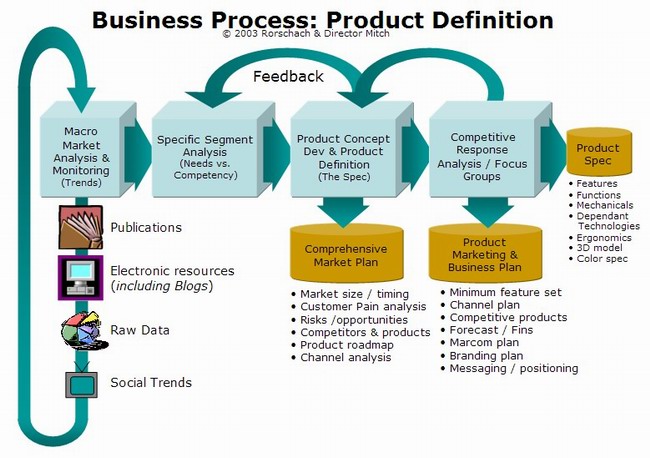
1. Know the Total Available Market Space: The whole process is an iterative cycle, and I am a big believer in understanding trends in your entire chain (end customers, brand company, system houses, component vendors, raw materials) to help identify where the most customer pain exists. Your mission is to come up with a product that has a minimally acceptable feature set (validated by end customers) and get it to market as quickly as possible. At the same time, you must play scenario-based strategy games by anticipating competitor response and planning counter-strike tactics.
In your voluminous spare time, you must voraciously consume as much relevant market data as possible, but also be aware of the end customer trends. Let me just pander to the community here and state that blogs (Indeed. Blogs.) can play a huge role in spotting trends, pain points, and possible solutions. Bloggers love to review things, complain, praise, and otherwise opine. It’s a self-replenishing natural resource for the savvy marketeer.
2. *Really* know your chosen market segment: Can you really build something for this segment? Most startups fail: not because of bad core technology, not because of bad sales/marketing, but because of poor execution. So make sure you have (or can buy) the competence to get the product to market. That having been said, customers are notoriously fickle, but you would never bring a product to market without patron customers (read:sugar-daddies) who will assuredly buy your wares as you have pre-sold them on the Specification and have their input.
3. Construct a brief analysis of your market segment: Share it with your customers. Have them edit/correct your assumptions. This requires the networking skills to have a database of market-knowledgeable people you can turn to for advice and constructive criticism.
4. Write a brief business plan for your product: this should not take months. This can be PowerPoint. More than one person should read and edit the plan. If you are agonizing over prose then you are not going quickly enough. You should have multiple revs. Stuff should be missing. Assumptions MUST be listed.
5. Write the spec => hand it off to engineering/operations => ride them for feedback until they run away screaming at your sight: Take the same spec to key customers, have them edit the details. Beg/borrow/steal enough resources to put together a simple demo to show off the main features or mockup details of your spec. Amazing deals can be won with an “ah-ha!” demo.
It may seem pedantic, but you’d be surprised how many startups skip most of these steps because some “genius” founder “knows exactly what product to make.” If you have one guy who knows all the answers, go find yourself another team. If you know all the answers, change jobs: it sucks to be the only omnipotent being in a world of losers.
So what happens when you do all this stuff and it still doesn’t work? It’s not the end of the world, and rejection is truly the best mentor.
1. Downgrade the feature set: just make sure its minimally acceptable
2. Downgrade the target customers: maybe you’ve been going after prima-donna customers when what you really need are meat-and-potatoes buyers. Expand your business development to include non traditional targets. Ask your sales guys, they probably have more ideas than you expect.
3. Partner with the enemy: Do you have some of the pieces, but failed on the whole enchilada? Try going to your competitor and put together a deal that plays on both partner’s strengths.
So there you have it, and by all means, throw it all out the window when the crisis/opportunity dictates. Rules are made to be broken, and changing course in increments more frequently is still better than sailing in the wrong direction. In an upcoming post I’ll write more about doing business in Japan, which consists of an intoxicating mixture of formality, informality, and bizarre settings that may land your company profits while teaching you about life on another planet.

No comments:
Post a Comment